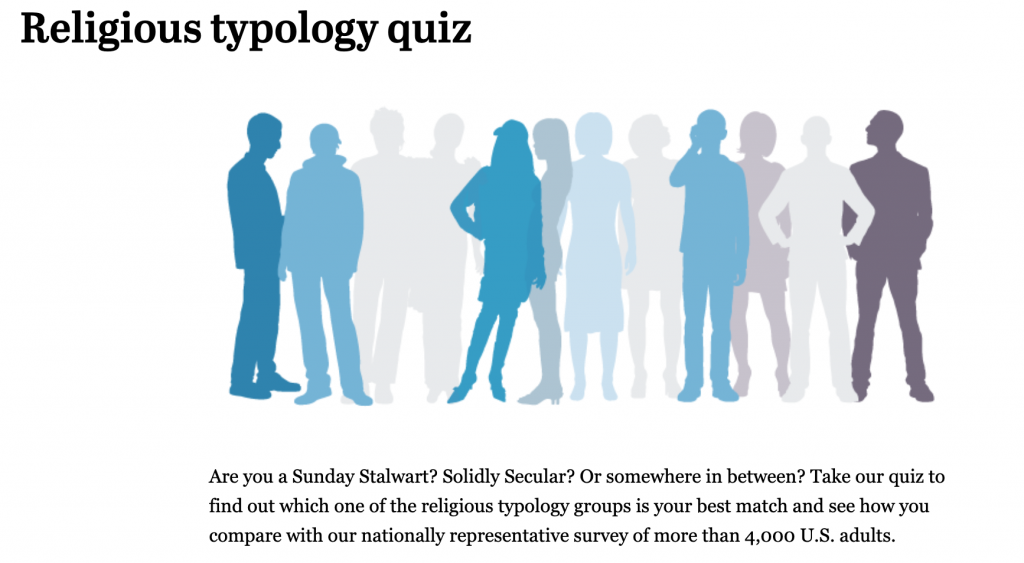If Cosmo and Buzzfeed have taught us anything, it’s that we love personality quizzes. Sure, many of them aren’t valid measures of personality, but it can still be fun to find out what kind of Disney princess you are or what your food truck preference says about the way you handle rejection in life.


But the logic behind these fun quizzes can has a big impact in social science, because they are all based on looking for patterns in how people answer questions. We can reverse-engineer the process; instead of going in with a set of personality types and designing a survey, researchers can use a method called Latent Class Analysis to look at completed surveys and see which patterns of answers emerge from the data. By comparing those patterns to existing theories, they can come up with new categories that explain how people think, especially people who fall in between the strong or obvious categories.
The Pew Research Center has done this with different styles of religious experiences, and you can take a quiz to see which type best fits you.

Bart Bonikowski and Paul DiMaggio use this approach to identify different kinds of nationalism in the U.S. There are ardent nationalists and people who are disengaged from nationalism, but the middle is more interesting. Between these two groups, there are also people with relatively moderate national pride who still think only certain people are “truly American,” and there are folks who have higher national pride, but a more inclusive vision of who belongs.
I also used this method in a recent paper with Jack Delehanty and Penny Edgell looking at different kinds of religious expression in the public sphere. In a new paper coming soon, our team also finds patterns in how people think about who shares their vision for American society.
Religion, nationalism, and even racism? These are heavier topics than the typical personality quiz covers, but the cool part about this method is that it is less intrusive than directly asking people what they think about these topics. When we ask simpler questions—but more of them—and then look for patterns in the answers, we can learn a lot more about what they actually think.

Comments 15
Garvon Momanyi — June 3, 2019
This is an interesting article on how personality quizzes helps us know the kind of people we are based on various topics such as religion and through the patterns that we use when answering these questions, it helps researchers identify a pattern on how we are thinking.
kate wilson — June 14, 2019
Can you double-check the hyperlink to the Bonikowski & DeMaggio quiz? Thanks
Brian — July 4, 2019
The logic behind these fun quizzes can has a big impact in social science.
https://theimpossible-quiz.co/
Jesus Clane — August 18, 2020
Since I have posted several quizzes on the best platform on the Buzzfeed, that’s why I know how most of the individuals are going to reply. Getting valuable responses from different individuals is very entertaining for me. It helps me to write my essay about different behaviors with the help of online writers by reading on https://edubirdie.net/blog/is-edubirdie-legal-or-cheating website. Thanks to the all individuals who reply to me online.
Elizabeth03 — September 2, 2020
Have you ever heard about american food frequently chosen by students? We've prepared a full list of students' favorites. Know about their top choice right now.
oncasinosite — November 17, 2021
Can add up your article, believe that there is something you can add, visit the site
Olga Bowden — December 14, 2021
I've posted several quizzes on the best platform on Buzzfeed, I know how the majority of people will respond on the website.
Briggs — January 14, 2022
I have certainly played many personality quizzes, even published my scores on social channels to flaunt my score. There is something so exciting about killing time on these things Eco Friendly Products Australia
Floyd McKinney — August 9, 2022
Your article is very interesting cladder.
Alex jon — August 31, 2022
We are sharing the latest updates of seriale turcesti subtitrat in Romana on our website daily. if you like to watch seiale turcesti subtitrat in Romana so visit Seversin seriale latimp and get all new updates of seriale turcesti with high resolution.
Adam Dever — November 30, 2022
I can educate you to look for the assistance concerning proficient authors from the clinical individual data mining assignment solutions https://www.aussiessay.com/data-mining-assignment-help/. This will assist you with adapting to composed work of any intricacy in the most limited conceivable time without counterfeiting.
Wordle answer today — June 21, 2023
If you are having trouble solving crosswords within the wordle game, please see the wordle answer today for solutions.
SMM Panel One — July 15, 2023
Ready to take your social media presence to unprecedented heights? Look no further than our Best SMM Panel, your one-stop destination for unrivaled social media marketing solutions. Our panel is packed with a comprehensive range of services, including likes, followers, comments, and more, designed to propel your online influence across all major social media platforms.
SMM Panel — September 18, 2023
If you're in search of an efficient and reliable way to boost your social media presence, look no further than the leading Indian SMM panel. SMMPanel2 offers a range of top-notch services tailored to the Indian market to help you achieve your social media marketing goals.
Sefonca — November 8, 2023
I learned many knowledge in your post, play game just fall will helps you relieve stress and have more energy.